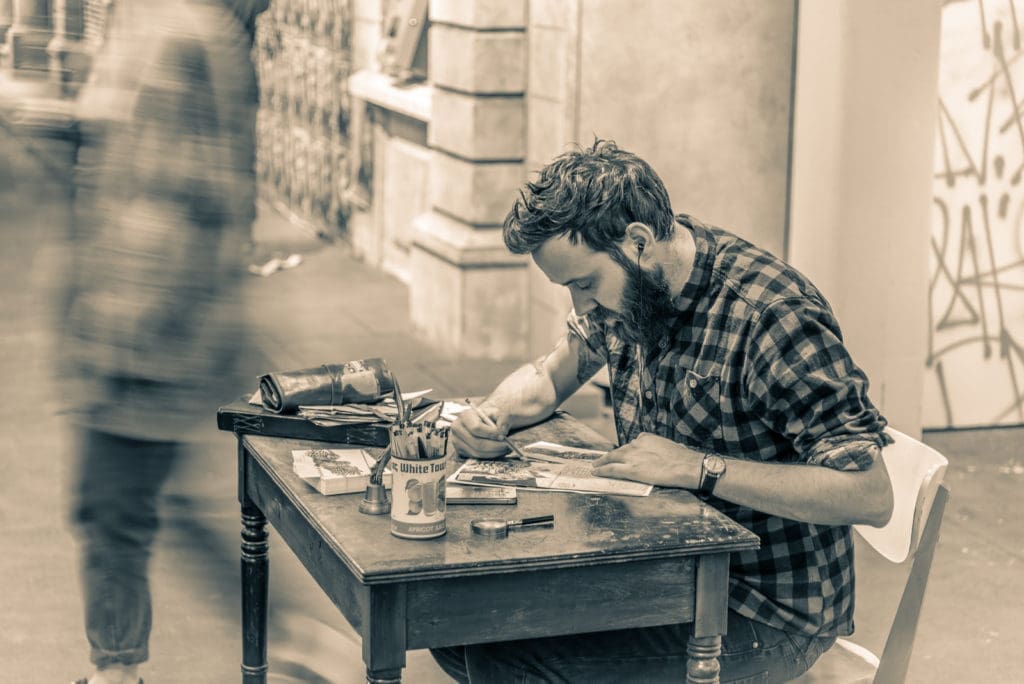FAQs
Answers to your Questions
ABOUT THE ARTIST
Mark Powell was born in Yorkshire and attended Huddersfield University. He enrolled one day purely by accident. He was fired from his then job one day and decided to visit in the town. Bored, he decided to look around the art department, the term had just started, and began talking to the head of the department. Before he knew what was happening and armed with only a few sketches that he had drawn at the many many jobs he had been hired and fired from or the many houses he had lived in, he signed a few pieces of paper and was then studying Fine Art Drawing and Painting. The first year was a little up and down, with no student loans until the second year and mostly nowhere to live for the first year. He managed to get some work done, though was termed as a ‘terrible artist’ by one course tutor. The second and third year went a little more smoothly and graduation came and went, he skipped the graduation ceremony. In the summer of 2006, the year of graduation, he was invited to show in a few spots in America, fun ensued. On the return to the UK and with only £1 in his pocket he had a to find a job and studio, more shows followed in various cities and nearly a year spent sleeping on a concrete floor in his studio in Leeds until an opportune moment and the chance to take a warehouse in Bow, London. A rather hectic year followed of parties and work until the building was condemned. Moving to Brick Lane in East London and being featured on the culture website Colossal meant that within a few hours of that feature leading to all his work being sold he could quit and become a full time artist. With the help of The Other Art fair London noticed. Travel, group shows and solo shows followed a plenty. And so the story goes…
What inspires you?
I find inspiration from artists of many styles. I find that it comes not from people of similar style but from artists that make you stand back and linger. Jean Michel Basquiat, David Hockney, Samuel Bassett, Anthony Micallef, Richard Hamilton etc
What got you started with this style?
After we were evicted from the warehouse in London, at which point i was painting large scale paintings, i had to work smaller. I had found an envelope that was sent from the trenches in World war one. The solider had sent it just before ‘going over the top’. With the likelihood that the solider never returned i decided to draw what he may have looked like as an old man. And so it started. In an increasingly digital age i want to save as much as i can in the way of maps etc and ‘upcycle’ them. The pairing of elderly people and antique documents is a natural one. Both have an untold history upon the face of it. A suggestion.
Why a biro?
I choose a biro because it is the most simple and readily available tool to hand. I want to show how easy it is to have the chance to create. I want it to inspire people to give it a go without feeling the need to spend money on arts and crafts.
When did you start drawing?
I dont remember a point at which i didnt draw. Even when i am not drawing ‘real’ drawings for shows i am drawing in sketchbooks or painting etc. How else is anyone going to improve if not by hard incessant work.

Do you know the people you draw?
I tend not to know the people i draw as i prefer to retain the mystery of travel of both the subject and ‘canvas’
What is your favourite piece and why?
I tend to dislike most of the work i produce, on occasion i do like a piece that can last up to 5 minutes but then i have to get back to work to produce something better. I doubt i would like to be too satisfied with anything i produce.
Any advice for drawing?
When drawing with a biro i find that it is all about the pressure applied on the tip. To avoid the ink build up that tends to happen with ballpoint pens keep an extra piece of paper to roll the tip on. Use it often. Pens that have used more ink have a quicker flow of ink so only use them for darker areas and use newer pens for lighter areas. Other than that simply keep working and work often otherwise youll never improve.
How do you draw on antique documents?
When drawing on antique documents you will find that each one is different and so your technique will have to differ on each. Some take ink better than others, some are thicker than others. Time will educate you on this. Always remember to work from light to dark with the pen.
Any advice on becoming an artist?
There is no formula for this. I worked so many jobs and lived in so many houses but the only constant was my creating. Then one day someone noticed and i became an full time artist. But you dont need to do it full time to be an artist!
How do you choose a particular drawing?
Each face i choose to draw has to have character and a suggestion of a history to tell. That way the viewer can create any narrative of a life that may have been lived. The same applies to the postcards or documents etc, neither the face or document have a connection beyond the fact both have an aesthetic quality of a history.